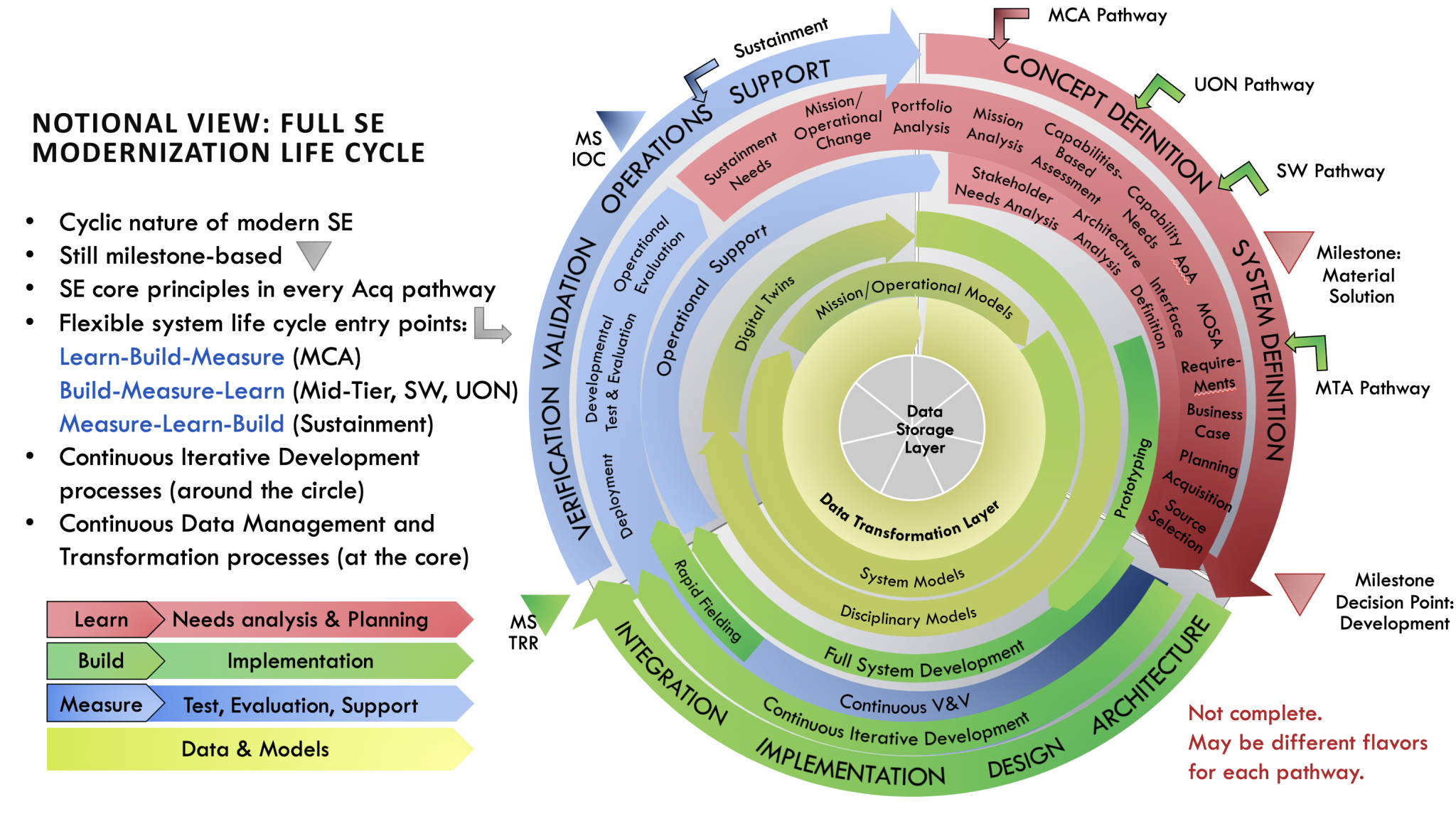SERC Researchers Design New Lifecycle Models to Reflect Flow of Data

A new SERC report presents ideas for modeling systems engineering (SE) to advance the digital transformation of acquisition within the Department of Defense (DoD).
In Program Managers Guide to Digital and Agile Systems Engineering Process Transformation, SERC CTO Thomas McDermott, co-principal investigator William Benjamin of Georgia Tech Research Institute, and their team of researchers and students examined the need to modernize systems engineering applications despite organizational challenges. This work centered on recent Congressional guidance to address four systems engineering focus areas: Digital Engineering, Modular Open Systems Approach (MOSA), Agile Development, and Mission Engineering (ME). Each of these areas can be considered components of SE lifecycle management.
“There is a lack of an integrated approach to implementation of SE focus areas that is creating a delay in full implementation of the digital transformation, which is necessary to ensure the relevant guidance, skills, and training are available to deliver a robust, disciplined approach to weapon systems acquisition,” the report said.
The DoD’s Digital Engineering Strategy formalizes the role of digital engineering and model-based systems engineering for digital transformation, which is critical in an environment of global challenges, dynamic threats, evolving technologies and increasing life expectancy of systems in operation. This transformation requires updating acquisition and SE practices, and it requires fundamental shifts across the DoD and in its workforce training (see Simulation Training Environment for Digital Engineering for an example).
The report explores the history of SE and finds aspects such as mission integration, digital systems engineering, and agile systems engineering evolving differently in diverse disciplines, creating organizational and process barriers. Furthermore, policy and guidance follow independent terminology across focus areas and acquisition pathways; show limited reasoning for digital transformation; and remain milestone driven, overly focused on new development, and lacking focus on updates and sustainment.
A particular focus is the digital transformation of both SE and acquisition. “DoD efforts have been more focused on the creation of authoritative sources of data and models than the value achieved by digitizing the underlying transformations,” the report said. “This is creating slow uptake of modernized systems engineering capabilities and processes in DoD program offices.” The report went on to state that “the common modernization driver in all of these focus areas is seamless and efficient transfer of data and models from underlying performance drivers through models to decisions, as well as ease of drilling back down from decisions to data.”
Acquisition program managers face process changes calling for more rapid deployment of capabilities, better weapon system portfolio management, and efficiencies created through digital transformation. To support them, it is necessary to organize lessons learned, best practices, and standard guidance with a holistic approach of SE modernization focus areas pertaining to digital engineering, agile methods, modular open systems approach, mission engineering, modeling and simulation, and other relevant methodologies.
The research goals for this report included creating an integrating framework that incorporates activities in each SE domain and generates options for a management and process structure; making recommendations to implement a digital environment and descriptive modeling practices; developing artifacts (policies, instructions and guidance, plans, lessons learned, interview narratives, technical data, etc.) for an accessible body of knowledge; and providing outreach to government acquisition leads, program offices, science and technology organizations and other entities.
The figure below provides a high-level conceptual view of the integration framework, depicting all aspects of SE in the acquisition process as continuous and centered on data. It is in effect just a mental model focused on countering current SE and acquisition guidance that continues to operate with a model of linear, milestone-driven, technical and management processes relying on static, often document-based artifacts.

The new model shows a lifecycle layered from data to models to decision artifacts, presenting a more focused set of pain points that can define change modernization roadmaps. It highlights how DoD acquisition pathways begin at different points but should still follow a rigorous SE process model. It organizes the colors of the outer ring and related SE processes in the ‘Build/Measure/Learn’ context, pursuing a goal of continuous iterative development.
“As the team developed the integration framework, we came to realize first that mostly linear lifecycle mental model depictions like the ‘Vee’ model and the DoD’s ‘Defense Acquisition Wall Chart’ do not promote the future vision of data and models at the core of SE,” the report stated. “Since future systems will be ‘built for change’ using concepts of continuous iterative development, do the somewhat linear models of existing SE lifecycle representations still adequately guide us?”
Ongoing efforts by the SERC research team include analyzing a database of lessons-learned statements for an updated body of knowledge (BoK), building an ontological model that integrates independent terminology for written policy; and teaming with the Defense Acquisition University (DAU) to collect education and training artifacts. The team recommended the DoD invest in reference implementations focused on maturing data standards and data exchange methodologies, as well as standardization of related contract language and reference artifacts. The expectation is that SE modernization will take a number of years.
“The primary goal of this phase of SE modernization was to develop the integration framework that would bring these disciplinary and methodological views together,” the report concludes. “To do this we had to create a new mental model and set of visualizations that portray systems engineering in a different light. The basic process areas of systems engineering remain valid, but the lifecycle models and associated digital practices will look very different than the traditional underlying SE process in defense acquisition cycles.”
For more information on this research, contact Tom McDermott.
Follow updates and other SERC news on the SERC LinkedIn page.


